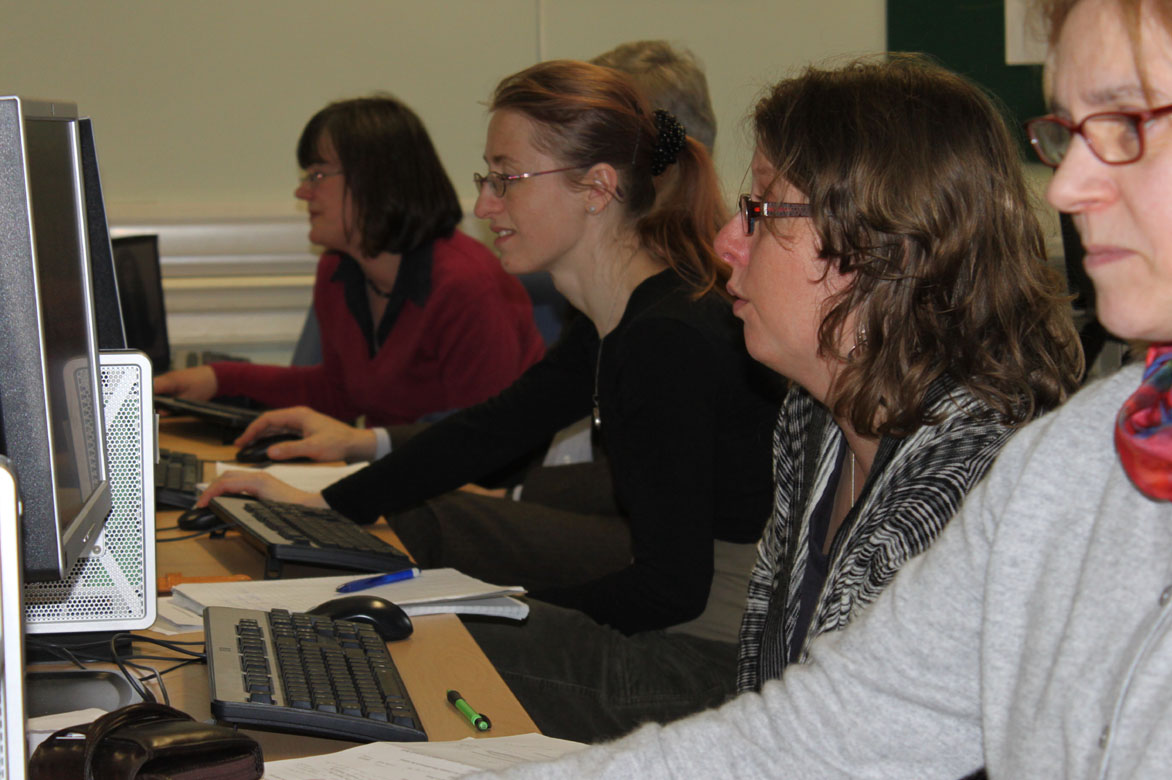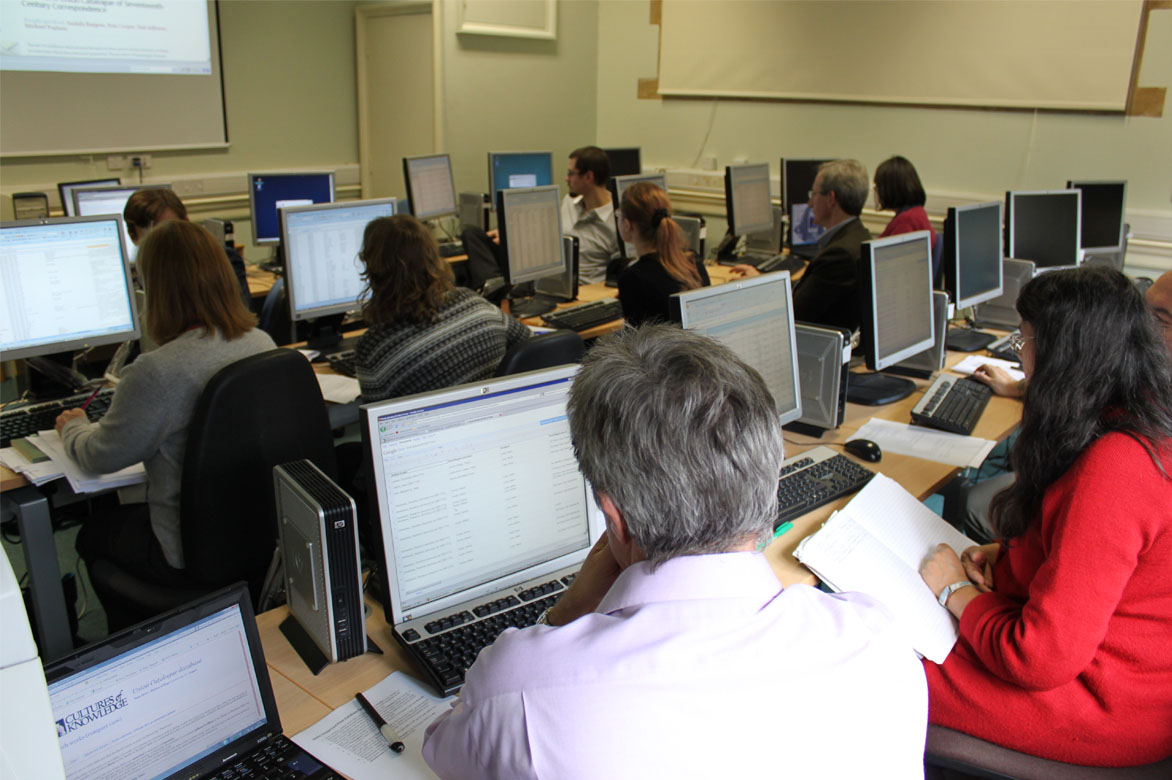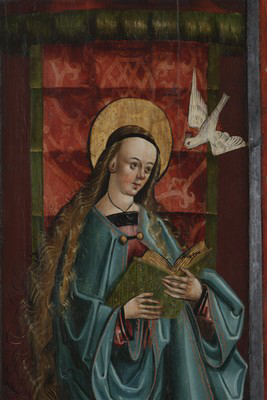
Testing the record-editing interface.

Comparing calendars.
Yesterday provided us with a valuable opportunity to bring individual CofK researchers together with OULS technical experts for a day of intensive training and consultation on various aspects of our nascent union catalogue of seventeenth-century intellectual correspondence. Scholars working on the Aubrey, Lister, Lhwyd, Hartlib, and Comenius collections explored the latest iteration of the pilot database; tested its online interface for the editing of letter records as well as our free-standing application for the collection of epistolary data; and compared individual calendars against each other as well as Project standards. The first version of the catalogue will be launched at the Universal Reformation conference, which will take place in Oxford on 21-23 September 2010.
 Last Saturday’s edition of The Early Music Show on BBC Radio 3 showcased on a fascinating collection of instrumental music from seventeenth-century Germany (land of Comenius, and a comparative focus our 2011 conference), known as Das Partiturbuch Ludwig. The manuscript was put together by musician Jacob Ludwig as a birthday present in 1662 for his former employer in Wolfenbüttel, Duke August of Gotha. Now in the care of the Herzog August Bibliothek, it provides a rare insight into the musical cultures of the Holy Roman Empire in the middle decades of the seventeenth century. The programme is available for the next few days on the iPlayer.
Last Saturday’s edition of The Early Music Show on BBC Radio 3 showcased on a fascinating collection of instrumental music from seventeenth-century Germany (land of Comenius, and a comparative focus our 2011 conference), known as Das Partiturbuch Ludwig. The manuscript was put together by musician Jacob Ludwig as a birthday present in 1662 for his former employer in Wolfenbüttel, Duke August of Gotha. Now in the care of the Herzog August Bibliothek, it provides a rare insight into the musical cultures of the Holy Roman Empire in the middle decades of the seventeenth century. The programme is available for the next few days on the iPlayer.
 We are currently seeking an Editorial Assistant (1.0FTE) to help us with the online publication of the Bodleian Library’s card catalogue of seventeenth-century manuscript correspondence. To be based in the History Faculty, the assistant, who will be employed for six months in the first instance, will be responsible for providing basic quality assurance on metadata from the cards which has been keyed and supplied by an outsourcing company. Working with online tools for the display and editing of data developed specifically for the Project, they will ensure that all records have been tagged in compliance with Project standards; that within each individual field dates, names, and places have been expressed correctly and without typographical errors; and implement necessary changes directly onto the records by means of a simple data entry interface. The closing date for applications is noon on Friday 5 February 2010; for full details and how to apply, please see here.
We are currently seeking an Editorial Assistant (1.0FTE) to help us with the online publication of the Bodleian Library’s card catalogue of seventeenth-century manuscript correspondence. To be based in the History Faculty, the assistant, who will be employed for six months in the first instance, will be responsible for providing basic quality assurance on metadata from the cards which has been keyed and supplied by an outsourcing company. Working with online tools for the display and editing of data developed specifically for the Project, they will ensure that all records have been tagged in compliance with Project standards; that within each individual field dates, names, and places have been expressed correctly and without typographical errors; and implement necessary changes directly onto the records by means of a simple data entry interface. The closing date for applications is noon on Friday 5 February 2010; for full details and how to apply, please see here.
 Dr Anna Marie Roos, our industrious Martin Lister Research Fellow, has contributed her expertise to Chemistry: A Volatile History, a three-part series of hour-long documentaries to be broadcast on BBC Four from the end of this week. As well as describing Lister’s various contributions to the discipline, Anna Marie provides insights into Boyle and The Skeptical Chymist, and Newton and alchemy, and assisted producers in their preparation for the programme (including confirming that Boyle did not in fact invent the phosphorous match). The first episode will be broadcast on Thursday 21 January at 9pm.
Dr Anna Marie Roos, our industrious Martin Lister Research Fellow, has contributed her expertise to Chemistry: A Volatile History, a three-part series of hour-long documentaries to be broadcast on BBC Four from the end of this week. As well as describing Lister’s various contributions to the discipline, Anna Marie provides insights into Boyle and The Skeptical Chymist, and Newton and alchemy, and assisted producers in their preparation for the programme (including confirming that Boyle did not in fact invent the phosphorous match). The first episode will be broadcast on Thursday 21 January at 9pm.
 Dr Anna Marie Roos, our Martin Lister Research Fellow, has just published an article on the seventeenth-century physician in Notes & Records of the Royal Society entitled ‘A Speculum of Chymical Practice: Isaac Newton, Martin Lister (1639–1712), and the Making of Telescopic Mirrors’. According to the abstract, ‘In 1674 … Martin Lister published a new method of making glass of antimony for telescopic mirrors, using Derbyshire cawk or barite as a flux. New manuscript evidence reveals that Sir Isaac Newton requested samples of the cawk and antimony from Lister through an intermediary named Nathaniel Johnston. An analysis of Lister’s paper and Johnston’s correspondence and its context reveals insights not only about Newton’s work with telescopic specula but also about his alchemical investigations. Analysing these sources also contributes to our understanding of the nature of correspondence networks in the early scientific revolution in England’. Subscribed users can access the full text of the article here.
Dr Anna Marie Roos, our Martin Lister Research Fellow, has just published an article on the seventeenth-century physician in Notes & Records of the Royal Society entitled ‘A Speculum of Chymical Practice: Isaac Newton, Martin Lister (1639–1712), and the Making of Telescopic Mirrors’. According to the abstract, ‘In 1674 … Martin Lister published a new method of making glass of antimony for telescopic mirrors, using Derbyshire cawk or barite as a flux. New manuscript evidence reveals that Sir Isaac Newton requested samples of the cawk and antimony from Lister through an intermediary named Nathaniel Johnston. An analysis of Lister’s paper and Johnston’s correspondence and its context reveals insights not only about Newton’s work with telescopic specula but also about his alchemical investigations. Analysing these sources also contributes to our understanding of the nature of correspondence networks in the early scientific revolution in England’. Subscribed users can access the full text of the article here.
James Brown
December 15, 2009
Exhibitions
Tags: Jan Amos Comenius
 A new exhibition on ‘Art of the Bohemian Reformation, 1380-1620′, curated by our Comenius Postdoctoral Fellow Dr Kateřina Horníčková, will open tomorrow (16 December 2009) at the Imperial Stable of Prague Castle. During the Reformation each of the Christian denominations in the Czech lands used art for representational purposes but, although many of these works survive, those created for non-Catholics have remained little known. The only Protestant church to enjoy legal recognition was the Utraquist; the Unity of Brethren (whose last bishop was Jan Amos Comenius), Lutherans, and Calvinists, did not gain full legal status until 1609. The exhibition, which showcases over 120 works, marks the 400th anniversary of this occasion. It encompasses late-fourteenth-century Hussitism and criticism of the use of images in religious practice, through a blossoming of art under Utraquism and Lutheranism, to the 1619 iconoclasm in St Vitus’s Cathedral, and the final years of the Refomation, which ended with the defeat of Protestant forces at the Battle of White Moutain. Klaudián’s map of Bohemia, the Codex of Jena, the Litoměřice Gradual with its depictions of Jan Hus, a carved altar by the Master IP from the church of the Our Lady upon Tyne, treasures from Kutná Hora, and works by the Rudolphinian artist Bartolomeus Spranger are among the sculptures, altar-pieces, ecclesiastical ornaments, and illuminated manuscripts through which it is possible to trace the radical shift from religious icon as object of veneration to that of image used for didactic, decorative, memorial, and representational purposes. The exhibition runs until 4 April 2010; for full details, see the website.
A new exhibition on ‘Art of the Bohemian Reformation, 1380-1620′, curated by our Comenius Postdoctoral Fellow Dr Kateřina Horníčková, will open tomorrow (16 December 2009) at the Imperial Stable of Prague Castle. During the Reformation each of the Christian denominations in the Czech lands used art for representational purposes but, although many of these works survive, those created for non-Catholics have remained little known. The only Protestant church to enjoy legal recognition was the Utraquist; the Unity of Brethren (whose last bishop was Jan Amos Comenius), Lutherans, and Calvinists, did not gain full legal status until 1609. The exhibition, which showcases over 120 works, marks the 400th anniversary of this occasion. It encompasses late-fourteenth-century Hussitism and criticism of the use of images in religious practice, through a blossoming of art under Utraquism and Lutheranism, to the 1619 iconoclasm in St Vitus’s Cathedral, and the final years of the Refomation, which ended with the defeat of Protestant forces at the Battle of White Moutain. Klaudián’s map of Bohemia, the Codex of Jena, the Litoměřice Gradual with its depictions of Jan Hus, a carved altar by the Master IP from the church of the Our Lady upon Tyne, treasures from Kutná Hora, and works by the Rudolphinian artist Bartolomeus Spranger are among the sculptures, altar-pieces, ecclesiastical ornaments, and illuminated manuscripts through which it is possible to trace the radical shift from religious icon as object of veneration to that of image used for didactic, decorative, memorial, and representational purposes. The exhibition runs until 4 April 2010; for full details, see the website.



 Last Saturday’s edition of
Last Saturday’s edition of  We are currently seeking an Editorial Assistant (1.0FTE) to help us with the online publication of the Bodleian Library’s
We are currently seeking an Editorial Assistant (1.0FTE) to help us with the online publication of the Bodleian Library’s 

 A new exhibition on ‘Art of the Bohemian Reformation, 1380-1620′, curated by our
A new exhibition on ‘Art of the Bohemian Reformation, 1380-1620′, curated by our 
 Join
Join 